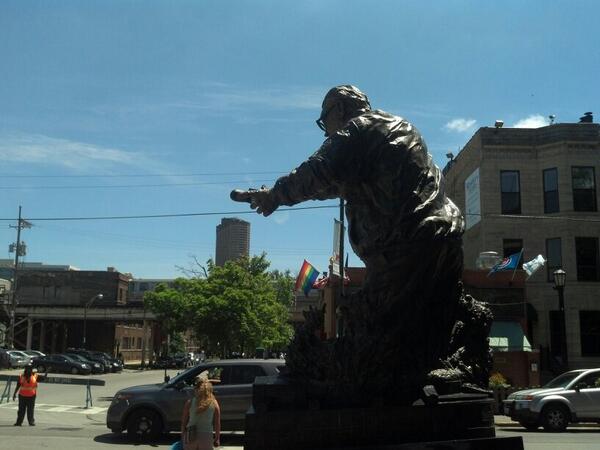For those who follow the Chicago Cubs from afar, Sunday’s day off might not make any sense. Sunday and baseball have gone together since time immemorial, or at least since cities lifted their ban on Sunday games in the 1930s. Sunday is the day for kids running the bases, special uniforms and/or caps and afternoon games (unless ESPN wants to show the game, instead). But for one Sunday in Chicago, baseball sat itself on the bench, instead. The team scheduled a doubleheader against the Nationals on Saturday, and left Sunday open as a result. So, there was baseball played, it’s just that the last Sunday in June means a bigger party on the North side of Chicago. And rather than trying to compete, the Cubs wisely chose to go with the flow instead. The flow, in this case, was the annual Chicago Pride Parade.
If you leave Wrigley Field and head three blocks east on Addison Street, past the CTA Red Line, you’ll arrive at Halsted Street, the heart of the LGBTQ community in Chicago. The Chicago Pride parade was originally called the Gay Pride parade, and the first one was held back in 1970. By the late 1970s it had made its way to the present route down Broadway Avenue, and the numbers of those in attendance — always not much better than an educated guess — kept on growing and growing over the years.
When I lived in the Wrigleyville area back in the early 1990s, annual attendance was around 100,000. I can say from experience that it was always the party of the year, and the one day that everyone — gay or straight — circled on their calendar. But, like any good secret, the word got out to the wider world. And gay rights gained more traction, which also helped to bolster the attendance numbers. By 2013, the parade had crowds, estimated at 1 million , coming from far and wide to be part of the fun.
I probably don’t need to tell anyone that even under the rosiest of scenarios, baseball can’t keep up with that type of explosive growth. People attending the parade and flooding into the area around Wrigley — which is also known as “Boystown” — would have been inconvenienced by the ballgame and vice versa. So, when the local alderman suggested a truce between Pride and Cubs Pride on Sunday, the Cubs went along with it. And a wonderful day was had by all.
Against this backdrop, it’s worth noting that baseball now lags behind the NBA and the NFL in terms of openly gay athletes. Have there been gay ballplayers through the years? Absolutely, and if you haven’t heard of Glenn Burke or Billy Bean then you should brush up on your baseball history a little bit. These players felt that they couldn’t come out while they were playing the game, and disclosing that information is always a personal prerogative, unless you’re the CEO of Apple.
How many gay players there are in MLB and in the minor leagues is anyone’s guess, but they’re certainly there. Gay men are now serving openly in the U.S. military and in Judas Priest. Perhaps MLB will catch up to the rest of our society soon.

